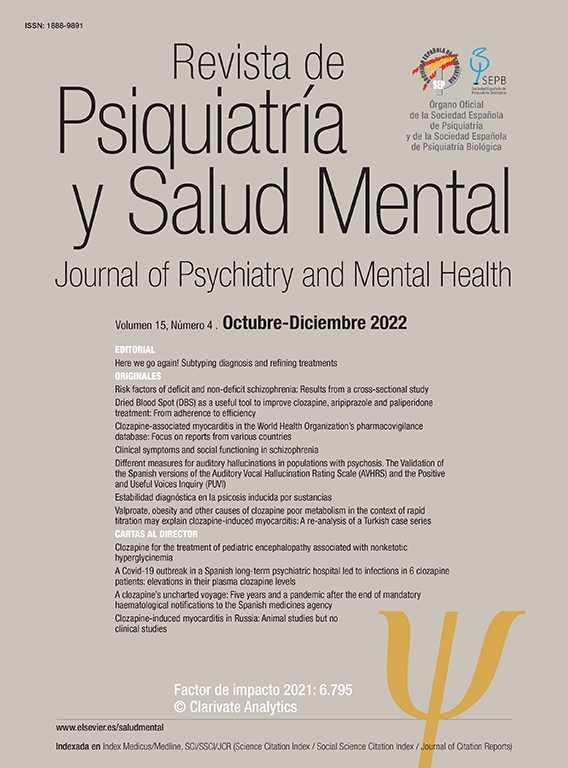Individuals with bipolar disorder (BD) often have co-occurring substance use disorders (SUDs), which substantially impoverish the course of illness. Despite the importance of this dual diagnosis, the evidence of the efficacy and safety of adjuvant treatments is mostly unknown.
ObjectiveTo perform a meta-analysis to evaluate the efficacy and safety of adjuvant drugs in patients with co-occurring BD and SUD.
MethodsWe searched PubMed, Scopus, and Web of Knowledge until 30th April 2022 for randomized clinical trials (RCT) evaluating the efficacy and safety of adjuvant drugs compared to placebo in patients with a dual diagnosis of BD and SUD. We meta-analyzed the effect of adjuvant drugs on general outcomes (illness severity, mania, depression, anxiety, abstinence, substance craving, substance use, gamma-GT, adherence, and adverse events) and used the results to objectively assess the quality of the evidence according to the Grading of Recommendations Assessment, Development, and Evaluation (GRADE) approach. For completeness, we also report the specific effects of specific adjuvant drugs in patients with specific substance disorders.
ResultsWe included 15 RCT studies (9 alcohol, 3 cocaine, 2 nicotine, and 1 cannabis) comprising 628 patients allocated to treatment and 622 to placebo. There was low-quality evidence that adjuvant drugs may reduce illness severity (g=−0.25, 95% CI: −0.44, −0.06), and very-low quality evidence that they may decrease substance use (g=−0.23, 95% CI: −0.44, −0.02) and increase substance abstinence (g=0.21, 95% CI: 0.04, 0.38).
DiscussionThere is low-quality evidence that adjuvant drugs may help reduce illness severity, probably via facilitating abstinence and lower substance use. However, the evidence is weak; thus, these results should be considered cautiously until better evidence exists.
A menudo, individuos con trastorno bipolar (TB) padecen trastornos por uso de sustancias (TUS), lo que empeora sustancialmente el curso de la enfermedad. A pesar de la importancia de este diagnóstico dual, la evidencia de la eficacia y seguridad de los fármacos adyuvantes es prácticamente desconocida.
ObjetivoRealizar un metaanálisis para evaluar la eficacia y seguridad de los fármacos adyuvantes en pacientes con un diagnóstico dual de TB y TUS.
MétodosRealizamos una búsqueda sistemática en PubMed, Scopus y Web of Knowledge (hasta el 30 de abril de 2022) de ensayos clínicos aleatorizados que evaluaban la eficacia y la seguridad de los fármacos adyuvantes en comparación con placebo en pacientes con un diagnóstico dual de TB y TUS. Metaanalizamos el efecto de los fármacos adyuvantes en 10 variables generales (severidad de la enfermedad, manía, depresión, ansiedad, abstinencia, ansiedad por la sustancia, uso de la sustancia, gamma-GT, adherencia, y eventos adversos) y utilizamos estos resultados para establecer la calidad de la evidencia de forma objetiva de acuerdo con el método denominado «Grading of Recommendations Assessment, Development, and Evaluation» (GRADE). Adicionalmente, reportamos los efectos específicos para cada fármaco adyuvante en pacientes con un uso de sustancia específico.
ResultadosIncluimos 15 estudios (9 alcohol, 3 cocaína, 2 nicotina, y uno cannabis) con un total de 628 pacientes asignados al tratamiento y 622 a placebo. Encontramos una evidencia de baja calidad de que los fármacos adyuvantes podrían reducir la gravedad de la enfermedad (g=−0,25, IC 95%: −0,44, −0,06), y una evidencia de muy baja calidad de que podrían reducir el uso de la sustancia (g=−0,23, IC 95%: −0,44, −0,02) e incrementar la abstinencia de la sustancia (g=0,21, IC 95%: 0,04, 0,38).
DiscusiónEste estudio muestra que hay una evidencia de baja calidad de que los fármacos adyuvantes pueden ayudar a reducir la gravedad de la enfermedad, probablemente al facilitar la abstinencia y reducir el consumo de sustancias. Por lo tanto, estos resultados deben considerarse con cautela hasta que exista una mayor evidencia.
Artículo
Comprando el artículo el PDF del mismo podrá ser descargado
Precio 19,34 €
Comprar ahora











